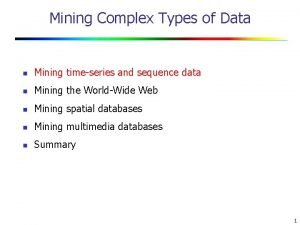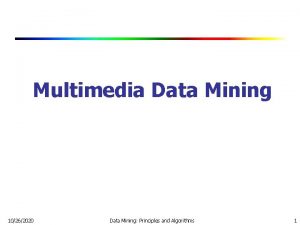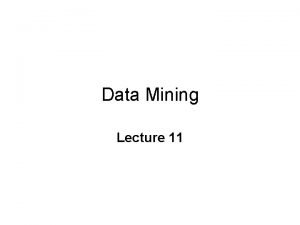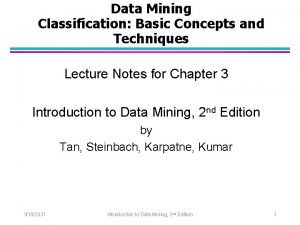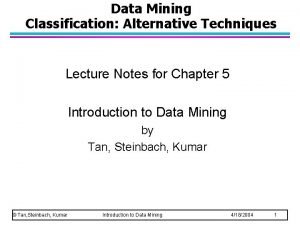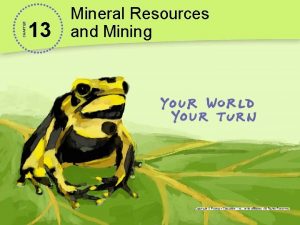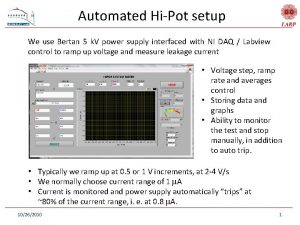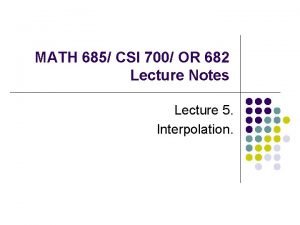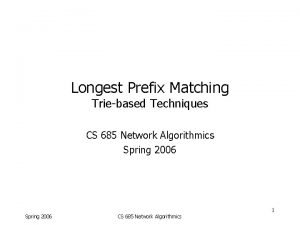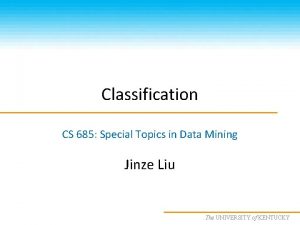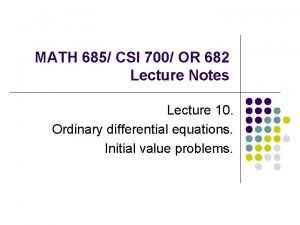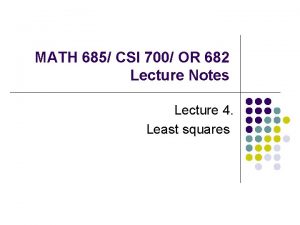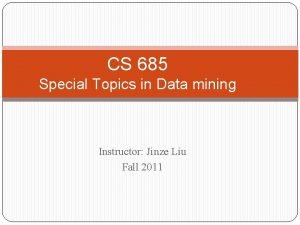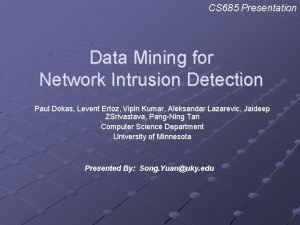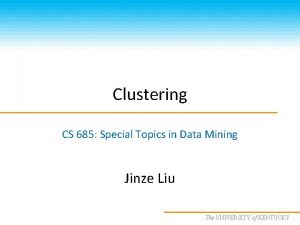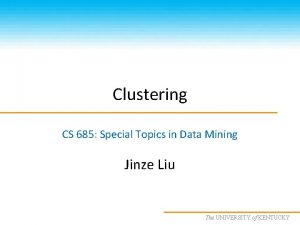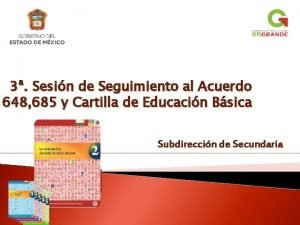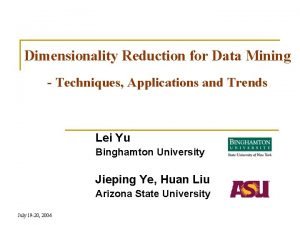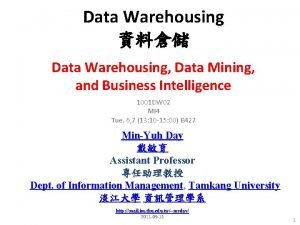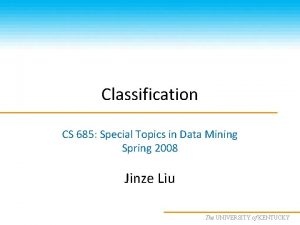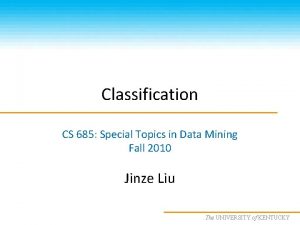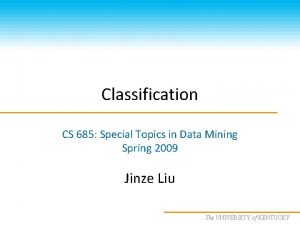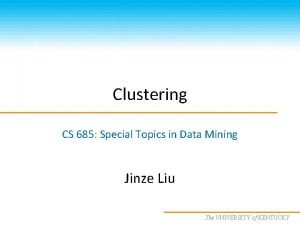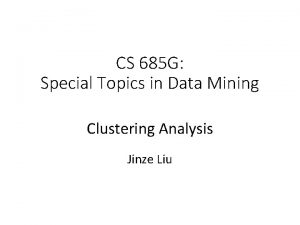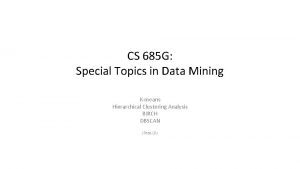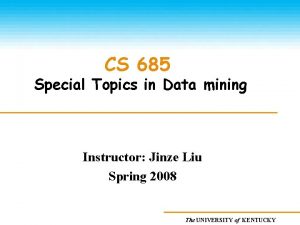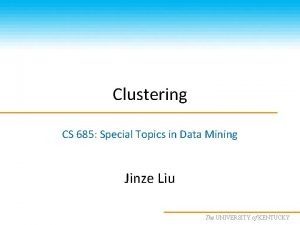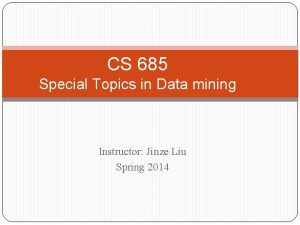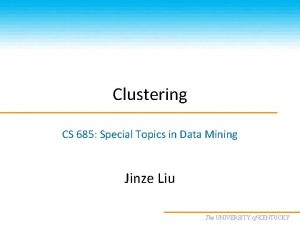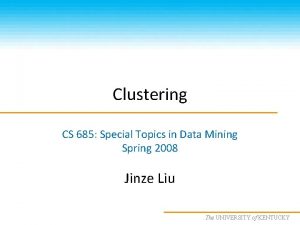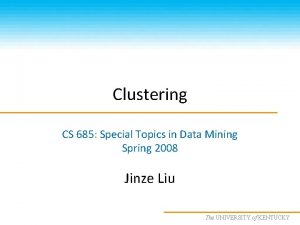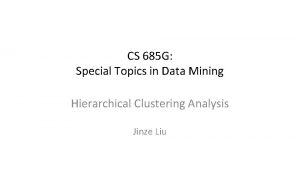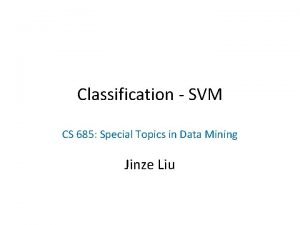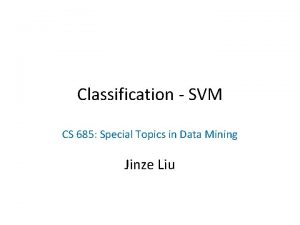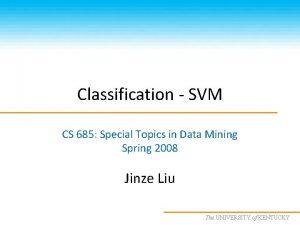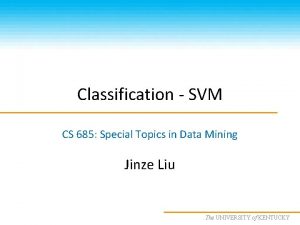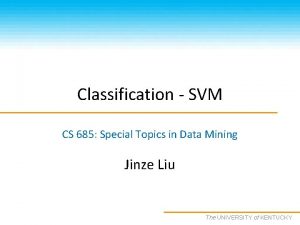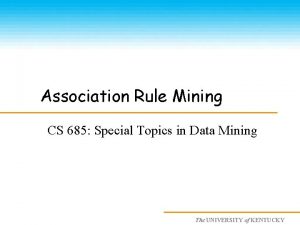Classification CS 685 Special Topics in Data Mining




























- Slides: 28

Classification CS 685: Special Topics in Data Mining Jinze Liu The UNIVERSITY KENTUCKY CS 685 : Special Topics in Dataof Mining, UKY

Classification and Prediction • • What is classification? What is regression? Issues regarding classification and prediction Classification by decision tree induction Scalable decision tree induction CS 685 : Special Topics in Data Mining, UKY

Classification vs. Prediction • Classification: – predicts categorical class labels – classifies data (constructs a model) based on the training set and the values (class labels) in a classifying attribute and uses it in classifying new data • Regression: – models continuous-valued functions, i. e. , predicts unknown or missing values • Typical Applications – – credit approval target marketing medical diagnosis treatment effectiveness analysis CS 685 : Special Topics in Data Mining, UKY

Why Classification? A motivating application • Credit approval – A bank wants to classify its customers based on whether they are expected to pay back their approved loans – The history of past customers is used to train the classifier – The classifier provides rules, which identify potentially reliable future customers – Classification rule: • If age = “ 31. . . 40” and income = high then credit_rating = excellent – Future customers • Paul: age = 35, income = high excellent credit rating • John: age = 20, income = medium fair credit rating CS 685 : Special Topics in Data Mining, UKY

Classification—A Two-Step Process • Model construction: describing a set of predetermined classes – Each tuple/sample is assumed to belong to a predefined class, as determined by the class label attribute – The set of tuples used for model construction is training set – The model is represented as classification rules, decision trees, or mathematical formulae • Model usage: for classifying future or unknown objects – Estimate accuracy of the model • The known label of test sample is compared with the classified result from the model • Accuracy rate is the percentage of test set samples that are correctly classified by the model • Test set is independent of training set • If the accuracy is acceptable, use the model to classify data tuples whose class labels are not known CS 685 : Special Topics in Data Mining, UKY

Classification Process (1): Model Construction Training Data Classification Algorithms Classifier (Model) IF rank = ‘professor’ OR years > 6 THEN tenured = ‘yes’ CS 685 : Special Topics in Data Mining, UKY

Classification Process (2): Use the Model in Prediction Classifier Testing Data Unseen Data (Jeff, Professor, 4) Tenured? CS 685 : Special Topics in Data Mining, UKY

Supervised vs. Unsupervised Learning • Supervised learning (classification) – Supervision: The training data (observations, measurements, etc. ) are accompanied by labels indicating the class of the observations – New data is classified based on the training set • Unsupervised learning (clustering) – The class labels of training data is unknown – Given a set of measurements, observations, etc. with the aim of establishing the existence of classes or clusters in the data CS 685 : Special Topics in Data Mining, UKY

Major Classification Models • • • Classification by decision tree induction Bayesian Classification Neural Networks Support Vector Machines (SVM) Classification Based on Associations Other Classification Methods – – KNN Boosting Bagging … CS 685 : Special Topics in Data Mining, UKY

Evaluating Classification Methods • Predictive accuracy • Speed and scalability – time to construct the model – time to use the model • Robustness – handling noise and missing values • Scalability – efficiency in disk-resident databases • Interpretability: – understanding and insight provided by the model • Goodness of rules – decision tree size – compactness of classification rules CS 685 : Special Topics in Data Mining, UKY

Decision Tree Training Dataset CS 685 : Special Topics in Data Mining, UKY

Output: A Decision Tree for “buys_computer” age? <=30 student? overcast 30. . 40 yes >40 credit rating? no yes excellent fair no yes CS 685 : Special Topics in Data Mining, UKY

Algorithm for Decision Tree Induction • Basic algorithm (a greedy algorithm) – Tree is constructed in a top-down recursive divide-and-conquer manner – At start, all the training examples are at the root – Attributes are categorical (if continuous-valued, they are discretized in advance) – Examples are partitioned recursively based on selected attributes – Test attributes are selected on the basis of a heuristic or statistical measure (e. g. , information gain) • Conditions for stopping partitioning – All samples for a given node belong to the same class – There are no remaining attributes for further partitioning – majority voting is employed for classifying the leaf – There are no samples left CS 685 : Special Topics in Data Mining, UKY

Attribute Selection Measure: Information Gain (ID 3/C 4. 5) n n n Select the attribute with the highest information gain S contains si tuples of class Ci for i = {1, …, m} information measures info required to classify any arbitrary tuple n entropy of attribute A with values {a 1, a 2, …, av} n information gained by branching on attribute A CS 685 : Special Topics in Data Mining, UKY

Attribute Selection by Information Gain Computation Class P: buys_computer = “yes” g Class N: buys_computer = “no” g I(p, n) = I(9, 5) =0. 940 g Compute the entropy for age: g means “age <=30” has 5 out of 14 samples, with 2 yes’es and 3 no’s. Hence Similarly, CS 685 : Special Topics in Data Mining, UKY

Splitting the samples using age <=30 age? >40 30. . . 40 labeled yes CS 685 : Special Topics in Data Mining, UKY

Natural Bias in The Information Gain Measure • Favor attributes with many values • An extreme example – Attribute “income” might have the highest information gain – A very broad decision tree of depth one – Inapplicable to any future data CS 685 : Special Topics in Data Mining, UKY

Alternative Measures • Gain ratio: penalize attributes like income by incorporating split information – • Split information is sensitive to how broadly and uniformly the attribute splits the data – • Gain ratio can be undefined or very large – Only test attributes with above average Gain CS 685 : Special Topics in Data Mining, UKY

Other Attribute Selection Measures • Gini index (CART, IBM Intelligent. Miner) – All attributes are assumed continuous-valued – Assume there exist several possible split values for each attribute – May need other tools, such as clustering, to get the possible split values – Can be modified for categorical attributes CS 685 : Special Topics in Data Mining, UKY

Gini Index (IBM Intelligent. Miner) • If a data set T contains examples from n classes, gini index, gini(T) is defined as where pj is the relative frequency of class j in T. • If a data set T is split into two subsets T 1 and T 2 with sizes N 1 and N 2 respectively, the gini index of the split data contains examples from n classes, the gini index gini(T) is defined as • The attribute provides the smallest ginisplit(T) is chosen to split the node (need to enumerate all possible splitting points for each attribute). CS 685 : Special Topics in Data Mining, UKY

Comparing Attribute Selection Measures • The three measures, in general, return good results but – Information gain: • biased towards multivalued attributes – Gain ratio: • tends to prefer unbalanced splits in which one partition is much smaller than the others – Gini index: • biased to multivalued attributes • has difficulty when # of classes is large • tends to favor tests that result in equal-sized partitions and purity in both partitions CS 685 : Special Topics in Data Mining, UKY

Extracting Classification Rules from Trees • Represent the knowledge in the form of IF-THEN rules • One rule is created for each path from the root to a leaf • Each attribute-value pair along a path forms a conjunction • The leaf node holds the class prediction • Rules are easier for humans to understand • Example IF age = “<=30” AND student = “no” THEN buys_computer = “no” IF age = “<=30” AND student = “yes” THEN buys_computer = “yes” IF age = “ 31… 40” THEN buys_computer = “yes” IF age = “>40” AND credit_rating = “excellent” THEN buys_computer = “yes” IF age = “>40” AND credit_rating = “fair” THEN buys_computer = “no” CS 685 : Special Topics in Data Mining, UKY

Avoid Overfitting in Classification • Overfitting: An induced tree may overfit the training data – Too many branches, some may reflect anomalies due to noise or outliers – Poor accuracy for unseen samples • Two approaches to avoid overfitting – Prepruning: Halt tree construction early—do not split a node if this would result in the goodness measure falling below a threshold • Difficult to choose an appropriate threshold – Postpruning: Remove branches from a “fully grown” tree—get a sequence of progressively pruned trees • Use a set of data different from the training data to decide which is the “best pruned tree” CS 685 : Special Topics in Data Mining, UKY

Approaches to Determine the Final Tree Size • Separate training (2/3) and testing (1/3) sets • Use cross validation, e. g. , 10 -fold cross validation • Use all the data for training – but apply a statistical test (e. g. , chi-square) to estimate whether expanding or pruning a node may improve the entire distribution • Use minimum description length (MDL) principle – halting growth of the tree when the encoding is minimized CS 685 : Special Topics in Data Mining, UKY

Minimum Description Length • The ideal MDL select the model with the shortest effective description that minimizes the sum of – The length, in bits, of an effective description of the model; and – The length, in bits, of an effective description of the data when encoded with help of the model CS 685 : Special Topics in Data Mining, UKY

Enhancements to basic decision tree induction • Allow for continuous-valued attributes – Dynamically define new discrete-valued attributes that partition the continuous attribute value into a discrete set of intervals • Handle missing attribute values – Assign the most common value of the attribute – Assign probability to each of the possible values • Attribute construction – Create new attributes based on existing ones that are sparsely represented – This reduces fragmentation, repetition, and replication CS 685 : Special Topics in Data Mining, UKY

Classification in Large Databases • Classification—a classical problem extensively studied by statisticians and machine learning researchers • Scalability: Classifying data sets with millions of examples and hundreds of attributes with reasonable speed • Why decision tree induction in data mining? – – relatively faster learning speed (than other classification methods) convertible to simple and easy to understand classification rules can use SQL queries for accessing databases comparable classification accuracy with other methods CS 685 : Special Topics in Data Mining, UKY

Scalable Decision Tree Induction Methods in Data Mining Studies • SLIQ (EDBT’ 96 — Mehta et al. ) – builds an index for each attribute and only class list and the current attribute list reside in memory • SPRINT (VLDB’ 96 — J. Shafer et al. ) – constructs an attribute list data structure • PUBLIC (VLDB’ 98 — Rastogi & Shim) – integrates tree splitting and tree pruning: stop growing the tree earlier • Rain. Forest (VLDB’ 98 — Gehrke, Ramakrishnan & Ganti) – separates the scalability aspects from the criteria that determine the quality of the tree – builds an AVC-list (attribute, value, class label) CS 685 : Special Topics in Data Mining, UKY
 Mining complex data types
Mining complex data types Multimedia data mining
Multimedia data mining Bayesian classification in data mining lecture notes
Bayesian classification in data mining lecture notes Classification and clustering in data mining
Classification and clustering in data mining Basic concepts of classification in data mining
Basic concepts of classification in data mining Classification alternative techniques in data mining
Classification alternative techniques in data mining Strip mining vs open pit mining
Strip mining vs open pit mining Mineral resources and mining chapter 13
Mineral resources and mining chapter 13 Difference between strip mining and open pit mining
Difference between strip mining and open pit mining Web text mining
Web text mining 1000-685
1000-685 847-685-1447
847-685-1447 Mth 685
Mth 685 Cs 685
Cs 685 Cs 685
Cs 685 Cs 685
Cs 685 Mth 685
Mth 685 Mth 685
Mth 685 Cs 685
Cs 685 Cs 685
Cs 685 Cs 685
Cs 685 Cs 685
Cs 685 Cs 685
Cs 685 Acuerdo 648
Acuerdo 648 Special investigative topics 3232 quizlet
Special investigative topics 3232 quizlet Dena schlosser
Dena schlosser Special topics in software engineering
Special topics in software engineering Data reduction in data mining
Data reduction in data mining What is kdd process in data mining
What is kdd process in data mining
